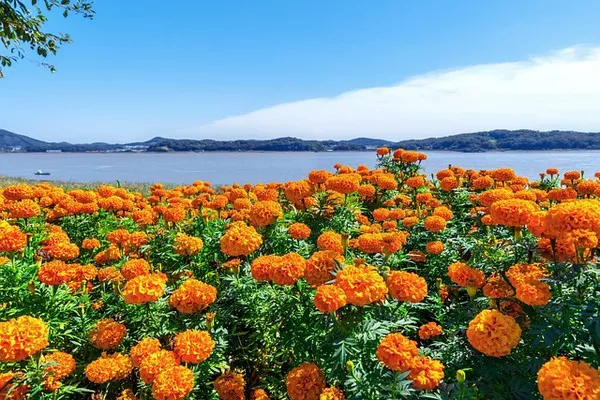Chickens are omnivores known for their diverse diet, which includes grains, insects, and kitchen scraps. While their primary dietary needs are met through these sources, providing a varied diet can contribute to their overall health and well-being. Incorporating flowers into a chicken’s diet is a creative way to introduce new nutrients and flavors. However, not all flowers are safe for chickens to consume. In this article, we will explore a range of flowers that chickens can safely eat, along with their potential benefits and precautions.
1. Marigolds (Calendula officinalis)
Marigolds are vibrant and hardy flowers often used as ornamental plants. Chickens can safely eat both the petals and leaves of marigolds. These flowers are believed to have antimicrobial and anti-inflammatory properties, which might help promote gut health in chickens. Marigolds can be introduced as a natural supplement to the diet and are often considered safe when consumed in moderation.
2. Nasturtiums (Tropaeolum majus)
Nasturtiums are not only visually appealing but also edible for both humans and chickens. The entire plant, including the leaves, flowers, and seeds, is safe for chickens to consume. Nasturtiums are rich in vitamins and minerals, including vitamin C and iron. Their peppery taste might also discourage intestinal parasites in chickens.
3. Calendula (Calendula officinalis)
Calendula, also known as pot marigold, is another flower that chickens can safely consume. The petals are the most commonly consumed part and are known for their bright color and mild flavor. Calendula petals are believed to have potential antiviral and immune-boosting properties, making them a valuable addition to a chicken’s diet.
4. Dandelions (Taraxacum officinale)
Dandelions are often considered weeds, but they are packed with nutrients and are safe for chickens to eat. Both the leaves and flowers of dandelions can be consumed by chickens. Dandelions are rich in vitamins A and K, as well as calcium. They also possess diuretic properties that might aid in maintaining urinary health in chickens.
5. Sunflowers (Helianthus annuus)
Sunflowers are not only a favorite among humans but can also be enjoyed by chickens. The seeds, once mature, are particularly beneficial due to their high fat and protein content. Sunflower petals can also be consumed, adding variety to the diet. It’s important to ensure that the sunflower seeds are fully ripe and dry before offering them to chickens.
6. Roses (Rosa spp.)
Roses are a popular flower, and while chickens can safely consume rose petals, there are some important considerations to keep in mind. Only offer organically grown roses, as commercially grown ones might be treated with pesticides harmful to chickens. Additionally, ensure that the petals are free from any chemicals before offering them to your flock.
7. Lavender (Lavandula spp.)
Lavender is not only fragrant but also has potential health benefits for chickens. Lavender flowers can be offered in small amounts to chickens, as they are believed to have calming effects and might help reduce stress in the flock. However, moderation is key, as excessive consumption might lead to digestive issues.
8. Bachelor’s Buttons (Centaurea cyanus)
Bachelor’s buttons, also known as cornflowers, produce beautiful blue flowers that chickens can safely eat. The flowers are not only visually appealing but might also provide antioxidants and contribute to overall dietary diversity.
9. Bee Balm (Monarda spp.)
Bee balm, with its vibrant blooms, can be a valuable addition to a chicken’s diet. The flowers are safe for consumption and might provide mild medicinal benefits. Some believe that bee balm has antibacterial and antiviral properties, although research is limited.
10. Pansies (Viola spp.)
Pansies are edible flowers that come in a variety of colors and can be a delightful treat for chickens. The petals are safe for consumption and might contain antioxidants. Pansies can be a great way to enhance the visual appeal of your chicken’s diet.
Conclusion
Incorporating a variety of flowers into a chicken’s diet can contribute to their overall health and well-being. Flowers such as marigolds, nasturtiums, dandelions, and sunflowers offer not only nutritional benefits but also add visual interest to their daily meals. While some flowers are safe in moderation, it’s crucial to avoid introducing flowers that might be toxic to chickens. Always research and verify the safety of a flower before offering it to your flock. Moreover, practicing organic gardening and avoiding pesticide-treated flowers is paramount to ensuring the safety of the flowers you provide to your chickens.
Remember that flowers should be introduced gradually and as part of a balanced diet. While some flowers might offer potential health benefits, overconsumption can still lead to digestive upset. A diverse diet, which includes a mix of grains, kitchen scraps, insects, and safe flowers, will contribute to your chickens’ overall health, happiness, and egg-laying performance.
Before making any significant changes to your chicken’s diet, it’s recommended to consult with a poultry veterinarian or an experienced poultry keeper. By following proper guidelines and considering the dietary needs of your chickens, you can create a harmonious and healthy environment for your feathered friends to thrive.


